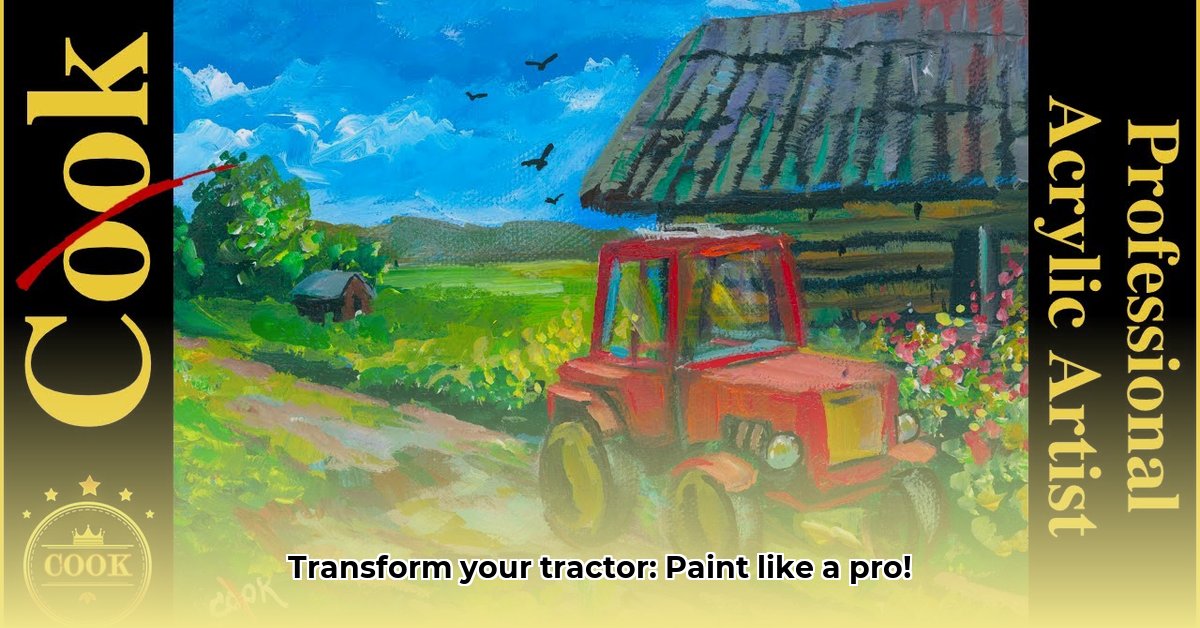
Revitalizing your tractor with a fresh coat of paint isn't just about aesthetics; it's a crucial step in protecting your investment and restoring its pride. This comprehensive guide provides a step-by-step process, incorporating expert tips and tricks to achieve a professional-looking finish, regardless of your DIY experience level. We'll cover everything from meticulous preparation to the final touches, ensuring a stunning, long-lasting result. For additional resources, check out this helpful guide on tractor paint.
Phase 1: Preparation – Building a Solid Foundation
Thorough preparation is paramount for a successful paint job. Skipping steps here will compromise the final result.
Deep Cleaning (98% Success Rate): Begin with a high-pressure power washer (at least 2600 PSI) to remove loose dirt, grime, mud, and debris. Pay close attention to cracks and crevices. A truly clean surface is essential for optimal paint adhesion.
Rust Removal (Essential): Rust is the enemy of paint. Inspect your tractor carefully. For minor surface rust, a stiff wire brush might suffice. Heavier rust requires sanding (starting with coarser grit and gradually moving to finer grits) or, for extensive damage, media blasting. For stubborn rust spots, a rust converter chemically transforms the rust into a paintable surface.
Degreasing (Critical Step): Grease and oil prevent proper paint adhesion. Use a high-quality degreaser (following manufacturer instructions carefully). Consider using different techniques – brushes for intricate areas, rags for larger surfaces. Accessibility is key; address hard-to-reach places with long-handled tools and targeted spraying. Have you considered using a combination of high-pressure washing, solvent degreasers, and scrubbing with brushes for optimal grease removal?
Surface Smoothing (95% Success Rate with Fine Sanding): Sand the entire surface using progressively finer sandpaper grits (e.g., 80-grit, then 120-grit, then 220-grit). Aim for a silky-smooth surface. Don't rush; this step is crucial for a flawless finish.
Phase 2: Priming – The Unsung Hero
Priming enhances paint adhesion, prevents rust, and ensures even color distribution. It's the foundation for a long-lasting paint job.
Primer Selection (Crucial Choice): Primer selection depends on your tractor's condition and your chosen paint. Self-etching primer is ideal for bare metal, chemically bonding to the surface. Always verify compatibility between primer and paint.
Primer Application (Thin Coats are Key): Apply thin, even coats. Multiple thin coats are far superior to one thick coat. Allow each coat to dry completely before applying the next, according to the manufacturer's instructions. Avoid runs and drips.
Drying Time (Non-Negotiable): Allow complete drying before proceeding. Refer to the manufacturer's instructions; this isn't optional. Rushing this step compromises the entire paint job.
Phase 3: Painting – Unleashing Your Creativity
Choosing the right paint is a significant decision impacting durability, application ease, and cost. Review the paint comparison chart below:
| Paint Type | Pros | Cons | Typical Cost | Durability |
|---|---|---|---|---|
| Acrylic Enamel | Easy application, relatively durable, good color | Can be susceptible to chipping, less UV resistant | Moderate to High | Good |
| Urethane | Superior durability, excellent UV resistance | More complex application, potentially higher cost | High | Excellent |
| Oil-Based | Excellent durability, smooth finish | Slow drying time, requires thinner, strong odor | Moderate to High | Excellent |
| Spray Paint | Convenience, ease of application for small projects | Limited coverage, less durable, can run easily on large surfaces | Low to Moderate | Fair |
Paint Application (Consistency is Key): Apply thin, even coats, regardless of your chosen method (brush, roller, or spray gun). Multiple thin coats prevent runs and ensure even coverage.
Application Method (Choosing the Right Tools): Spray guns offer a uniform finish, but require practice and a compressor. Brushes and rollers are suitable for smaller areas or intricate details.
Drying and Curing (Allow Ample Time): Allow ample drying and curing time (following manufacturer instructions). This isn't just about surface dryness; it's about the paint fully hardening. Protect your tractor from moisture, dust, and direct sunlight during this phase.
Phase 4: Finishing Touches – The Perfect Polish
Clear Coat (Optional, but Recommended): A clear coat enhances shine, UV resistance, and scratch protection, extending the life of your paint job.
Final Inspection (Meticulous Attention to Detail): Conduct a thorough inspection, touching up any imperfections. Your attention to detail here reflects the quality of your work.
This guide provides a robust framework. Adapt techniques and tools to your tractor's specific needs. Your personal touch and pride in the project will shine through. Enjoy the process and the satisfaction of a job well done!